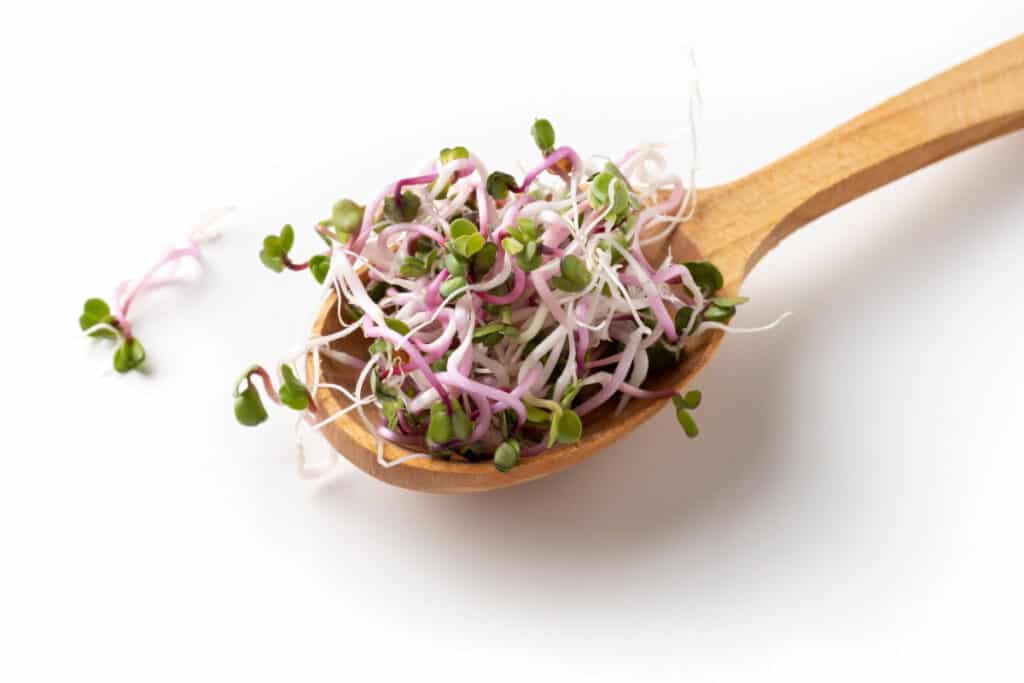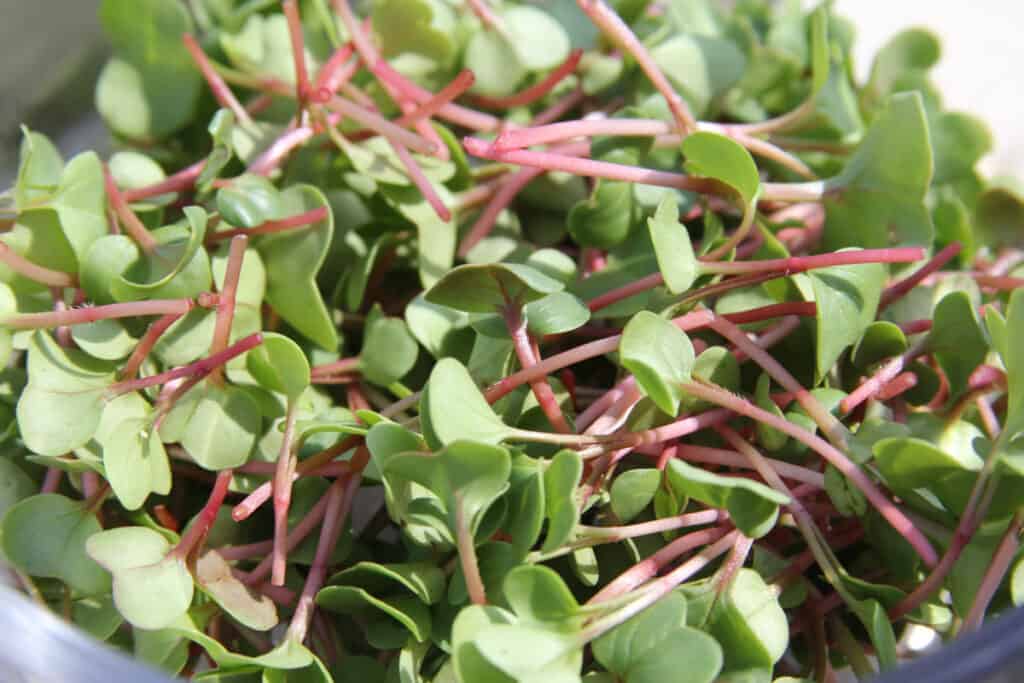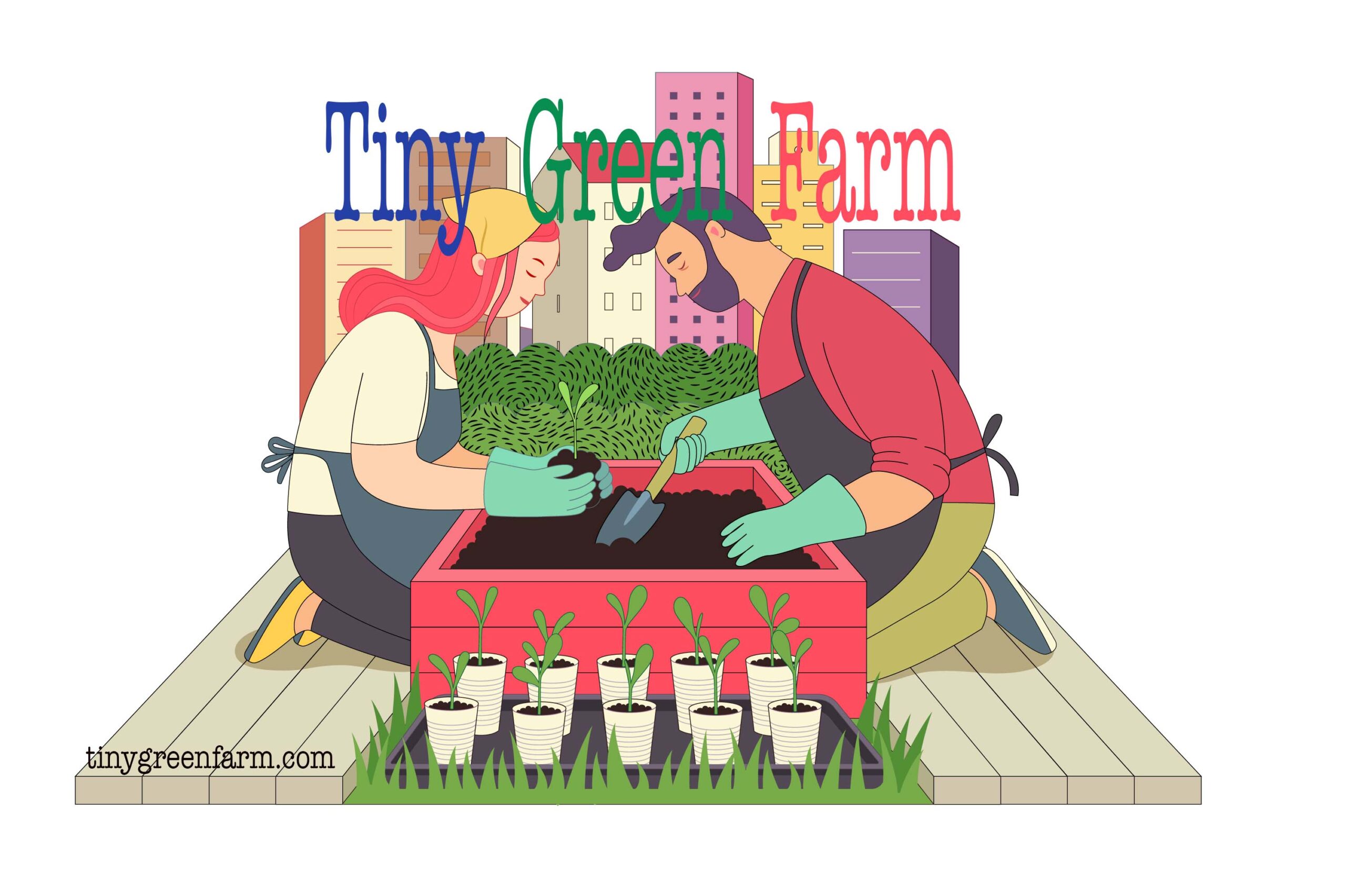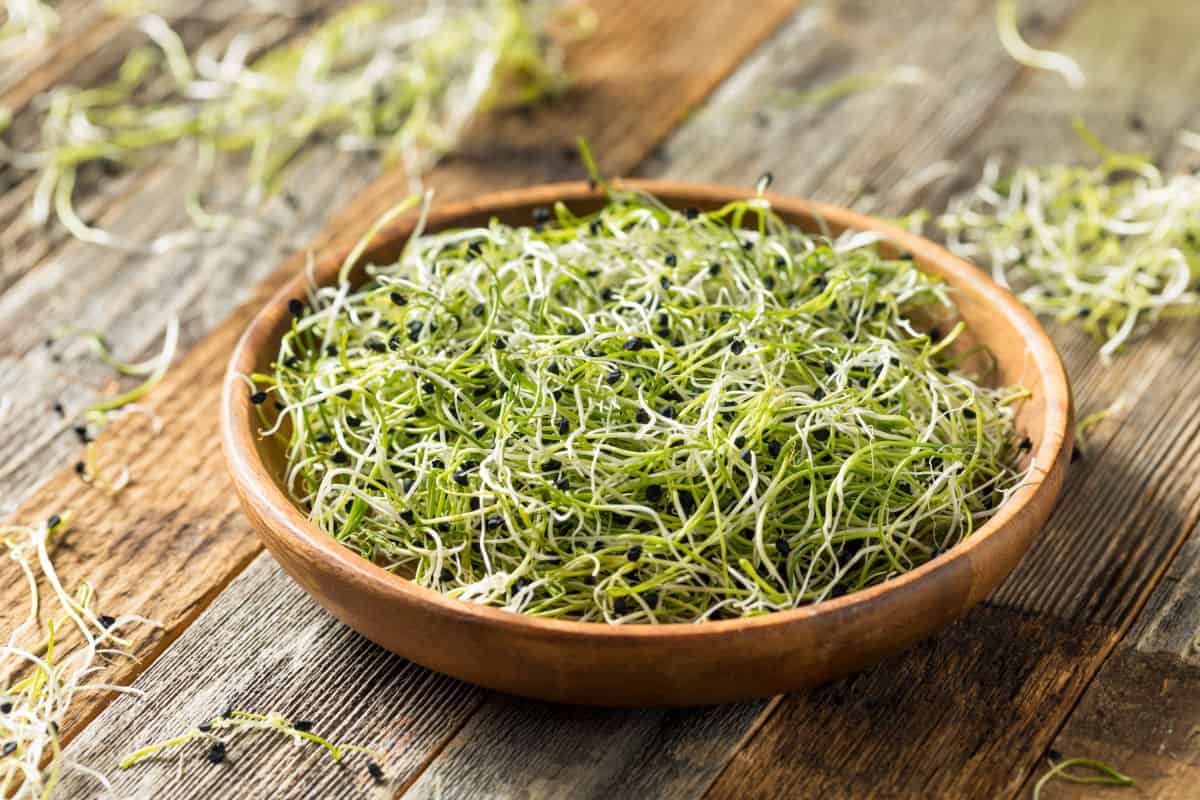Microgreens and sprouts are similar in that they are small plants that haven’t been allowed to grow to their full maturity. But they are grown using different processes, have different nutritional values, and have different tastes. Some seeds can be grown into both sprouts and microgreens, but microgreens come in a much larger variety.
1. Sprouts Are Seeds and Stem, Microgreens are Stems and Leaves
Sprouts are germinated seeds. Germination is the first stage of development for every plant. In this stage, the seed is stimulated to open up and develop the plant. The stimulus can include water and temperature. Water is a must, and the temperature requirement varies for different plants. The germinating seed also needs oxygen. Once the seed is in an ideal condition, it begins to absorb water and start growing a root, in order to absorb more water. Then it begins to grow a shoot or a stem. These are the sprouts. They represent a stage of development before leaves begin to grow on the stem.
Microgreens are bit farther ahead in their development than sprouts. While sprouts have no leaves, microgreens have developed their first leaves, that are called seed leaves, or cotyledons. These are called seed leaves because they are present in the seed along with the root and the shoot. They are all part of the embryo of the plant. Some microgreens are harvested after the seed leaves appear, for example sunflower greens. Other microgreens, such as peas, are allowed to grow longer to develop a set two or more true leaves.
When it comes to harvesting and eating sprouts, you basically eat the whole thing: the seed, or what is left of it, along with the root and the stem. With microgreens, you don’t eat the seeds and the roots because the are already intertwined in the soil or other growing medium. But you eat the stems and the leaves.
2. Sprouts Grow in Water, Microgreens Grow in Soil or Water
Another significant difference between sprouts and microgreens is how they are grown. Sprouts are grown in water. First you soak the seeds for a period of 6 to 12 hours, and then you keep them in moist conditions for several days. Jars or sprouting trays are the most common containers used for sprouting. It’s important to rinse and drain the seeds twice a day to prevent the growth of mold. Keeping the sprouts in dark is also recommended. The sprouts will also need air and relatively warm temperatures. Then the sprouts are ready within 3-5 days.
Microgreens need more than water. They need something for their roots to hold onto. So you can grow microgreens in soil, which is the easiest. You can also grow microgreens on hydroponic growing mats. These thin fabric-like mats replace the soil and provide enough support for the roots to grow. It is also possible to grow microgreens without soil or growing mats. They can be grown by using a double-tier grow tray with the top mash tray holding the seeds and the bottom tray holding the water for the roots.
Microgreens grown in water do not get the same nutrients as microgreens grown in soil. To make up for this, many hydroponic growers add nutrient solution to the water, to stimulate more vigorous growth and produce healthier plants.
Both soil and growing mats are widely used. Growing mats take up less space and are cleaner. But they are more expensive than soil, and they are more difficult to compost.
Microgreens also need light, after they have gone through the sprouting phase, which can be 1-3 days. Microgreen seeds are covered for the first few days and then the growing plants are exposed to light. Most microgreens need plenty of light, so if there isn’t enough sunshine, they need artificial lighting to develop properly. Not enough light can slow down their growth and hinder the development of strong stems and leaves.
Microgreens are grown for 1 to 2 weeks and sometimes longer for certain slow growing varieties. Many of them are harvested in their seed leaf stage, before the true leaves develop, for better flavor and texture. Some microgreens start to become woody, if you let them grow too long.
Microgreens are sown very densely, since they are only grown to 1 to 3 inches tall. Getting the right seed density is important for maximizing the growing area and to avoid the growth of pathogens. Microgreens also need mild to warm room temperatures to grow and sufficient air ventilation.
3. Popular Sprouts Include Mung Bean and Alfalfa, Microgreens Include, Peas and Sunflower

While there are several seed varieties that can be both sprouted and grown into microgreens, typically, people use different plant varieties for each purpose.
Some of the most popular sprouts are mung bean and alfalfa. Other varieties include broccoli, clover, and radish. Some people also sprout larger beans, such as chickpeas.
Sprouted beans and grains are also popular with raw foodists, such as chickpeas and quinoa. Sprouting increases the digestibility of beans and grains and reduces their anti-nutrient content. However, these still are best eaten cooked, and not raw. Even sprouted grains and beans are very difficult to digest and still have a lot of anti-nutrients, which can be toxic in the case of certain beans.
There are a lot more varieties of microgreens. The most popular ones are sunflower, pea, radish, cabbage, broccoli, arugula, mustard, kale, beet and amaranth. It’s possible to grow microgreens from mung beans, alfalfa, but they are not commonly grown. Leafy green vegetables and plants in the cabbage family are popular for their nice appearance and interesting flavor.

Both microgreens and sprouts are best grown from seeds specifically designated for sprouting or microgreen growing. Seeds labelled as sprouting will be suitable for growing microgreens and visa versa. Seed quality is important for both sprouts and microgreens so it’s not recommended to use regular garden seeds (because they may have been treated with chemicals) or seeds sold as beans and grains (because they may not be fresh enough to achieve high germination rates).
Another popular microgreen is wheatgrass, which some people call a sprout. But technically it’s more like a microgreen, since it has began the process of photosynthesis indicated by its vibrant green color.
4. Sprouts Add Texture, Microgreens Add Flavor and Visual Appeal
Sprouts and microgreens are also used in different ways and for different purposes. My favorite sprout is mung bean, and I love its crunchiness in Asian stir fries. That’s the most popular way bean sprouts are prepared. Bean sprouts are best slightly cooked, but other, more delicate sprouts are often consumed raw. These sprouts, such as alfalfa and broccoli, are most commonly used in sandwiches and salads. But they can be added to anything.
Most sprouts are pale, mostly white with a little bit of green, so they don’t add much visual appeal to meals. But they are a great substitute for lettuce or other greens in sandwiches because they are easier to chew on than leaves.
Microgreens, especially those in the brassica family such as radish, mustard, and cabbage, have a very powerful spicy flavor, which can be used to spice up dishes. Sunflowers have a mild nutty flavor, and peas have a sweet taste. So the flavor of microgreens is much more intense than the flavor of sprouts. As a result, they are often used as a spice, sprinkled on soups, grains or any dish really.
In addition, microgreens are more attractive than sprouts due to their bright colors. Some have green leaves, some have red leaves, some have purple leaves. And the stems are often a different color than the leaves, including white, pink, red, purple and green. For these reasons, chefs love to use microgreens to decorate dishes.
5. Sprouts and Microgreens Have Different Safety Issues
Sprouts are grown in damp, dark and crowded conditions, which encourages the growth of bacteria and fungi. There have been several e-coli outbreaks related to sprouts, so its important to follow good practices to avoid contamination.
Microgreens are susceptible to the same issues but to a lesser extent. Growing them in soil largely reduces the risk of contamination. The main issue with microgreens is the development of mold, which can happen on the surface of the soil or around the roots. Since the roots are not eaten and microgreens are harvested above the soil level, this reduces the risk of contamination. In addition, mold can be easily noticed on the surface of the soil and can be treated with a hydrogen-peroxide/vinegar solution.
Hydroponic growing mats are more prone to growing mold, simply because they don’t absorb as much moisture as soil, and there is a higher risk of a damp growing surface. But it’s just a matter of practice to figure out how much water and how often do hydroponic microgreens need, and you can grow them safely on growing mats.
Microgreens are also less crowded than sprouting seeds, which encourages air circulation. Even though microgreens are sawn densely, the seeds are not as close to each other and should not be touching and overlapping too much. Accurate sowing techniques can also reduce the risk of contamination.
But just like with any raw food, there is a risk of unwanted microorganisms. Cooking sprouts and microgreens can greatly reduce risk of food-born illnesses.
6. Sprouts and Microgreens Have Different Nutritional Profiles
Both sprouts and microgreens represent a very early phase in the development of a plant, and most of their nutritional content results from what is contained in the seed. Seeds are packed with all kinds of nutrients that support the plant in its early development. But those nutrients area only enough to feed the plant for a few days. So sprouts contain the nutrients of seeds in a more readily available format.
The sprouting process increases the level of several nutrients, including protein, folate, magnesium, phosphorus, and vitamins C and K.
Microgreens take is process even further. Microgreens grow for 7 days or longer, and at this stage, the plants need nutrients from the soil and the sun. Seeds absorb minerals from the soil which become available for your nutritional benefit. The quality of the soil or growing media has a direct effect on the nutrient content of microgreens as demonstrated by several studies.
When microgreens were grown on vermicompost and hydroponic growing pads, the cabbage and lettuce microgreens grown on vermicompost had significantly higher levels of 10 different minerals, including potassium, calcium, magnesium, zinc, and iron. You can learn more about this in this article from the Journal of Horticulture.
Organic materials such as compost and peat moss, and other soil amendments are also used to create a better quality soil.
So what you feed the roots will definitely make a difference in the quality of microgreens. What about hydroponically grown microgreens? These are grown without soil, in various mats in water. Most growers add nutrient solutions to the water they feed the microgreens with, in order to supply the same type of minerals that soil would provide.
The second reason why microgreens are more nutritions is due to the light they receive in the second phase of their growth. This could be sunlight, artificial light, or a combination that will allow the plant to perform photosynthesis. During photosynthesis, plants use water, carbon-dioxide, and light to create their own food in the form of carbohydrates. During the process, plants also create certain antioxidants, that have beneficial nutritional impacts for humans.
Some of the common antioxidants found in microgreens include:
- carotenoids such as beta carotene, lutein, and zeaxanthin
- Vitamin C
- Vitamin E
- Vitamin K1
- Polyphenols
Different types of microgreens contain these and other micronutrient in different amounts. In general, microgreens in the cabbage family appear to be the most nutritionally dense of all. In addition, microgreens contain significantly higher amounts of antioxidants and minerals than their adult counterparts.
Summary
- Sprouts represent the earliest development of a plant, and they are consumed in their entirety: seed, root and shoot. Microgreens are several days older with developed leaves. Only the shoots and the leaves are eaten.
- Sprouts are grown in damp conditions by being rinsed several times a day. Microgreens can be grown in soil or in water.
- The most popular sprouts are: mung bean, alfalfa, broccoli, clover, and radish. The most popular microgreens are sunflower, pea, radish, cabbage, broccoli, arugula, mustard, kale, beet and amaranth.
- Spouts are crunchy and provide texture to your meals. Microgreens provide flavor and visual appeal.
- Sprouts are more prone to developing food-borne diseases due to the wet conditions they are grown in.
- Microgreens are richer in nutrients due to photosynthesis and nutrients from soil.



Leave a Reply